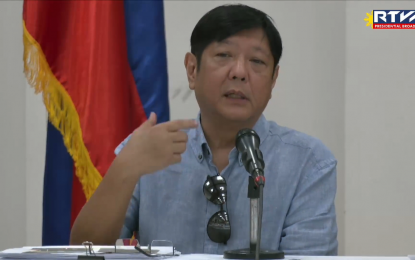
President Ferdinand R. Marcos Jr. (Screenshot from RTVM)
MANILA – President Ferdinand R. Marcos Jr. on Tuesday stressed the importance of preemptive evacuation to reduce the risk of losing lives in times of calamity.
In a post-typhoon situation briefing held in Antique, Marcos directed the local governments to ensure that all their constituents, especially those living near danger zones, are following the preemptive evacuation plans during emergency situations.
This, after Department of the Interior and Local Government regional office in Western Visayas (DILG-6) assistant director Maria Calpiza Sardua reported that the total number of deaths from Severe Tropical Storm Paeng has climbed to 36.
While he acknowledged that some people are reluctant to evacuate during disasters, Marcos said the government must do everything to convince them to cooperate and move them out of the danger zone.
"Mahirap talaga ipag-evacuate ang tao (It's really difficult to convince people to evacuate). That's really a problem. But you have to do it kahit na magalit nang kaunti sa'yo (even if they get mad at you). You have to do it," Marcos said during the briefing with select regional line agency directors at the Old Capitol Building in San Jose de Buenavista town.
"Preemptive evacuation is always a good idea. Basta maitabi mo 'yung tao (So long as you can evacuate the people), [you] can take them out of the area of danger, then you're way ahead kahit may (even if there is) property damage which we cannot do anything about anyway," he added.
During the briefing, Sardua told Marcos that 13 people in Antique, eight people each in Iloilo and Capiz, and seven in Aklan died when Paeng struck the country.
Sardua, citing the police report, said the causes of deaths were "drowning, swept by strong current of water, flash flood, landslide, hypothermia, cardiac arrest, difficulty in breathing, and electrocution."
She said local government units (LGUs) were "very well prepared," but admitted that they were "surprised" by the strength of Paeng.
To minimize deaths, Marcos said LGUs must exhaust all efforts to bring the resisting "10 percent" to evacuation centers before a typhoon hits their respective localities.
"Everywhere ka pumunta, problema ang evacuation. Ayaw nilang iwanan yung bahay nila eh (Everywhere you go, evacuation is the problem. People do not want to leave their house). Siyempre (Of course), you cannot blame them," he said.
Marcos gave the directive, as he noted that it is becoming a challenge to track the typhoons.
He said the government's disaster preparedness is vital in ensuring the safety of everyone and mitigating the adverse impact of typhoons on the country.
"Again, the preemptive evacuation is effective so let us do that. It saves many people," Marcos said.
"We really have to be prepared kasi (because) I don't know how to prepare. Bago ito (It's new to us). Everything is new. But siguro, 'yun na nga, (perhaps), we stay with the routine, with the procedures, the procedures of preemptive evacuation, our forward placement of relief goods and water supply," he added.
On Nov. 2, Marcos signed Proclamation 84, placing the regions of Calabarzon, Bicol, and Western Visayas, as well as the Bangsamoro Autonomous Region in Muslim Mindanao (BARMM) under a state of calamity to hasten the rescue, recovery, relief, and rehabilitation efforts of the government and private sector.
The declaration of a state of calamity will also help control the prices of basic necessities and prime commodities in the regions and give the government enough time to appropriate funds for relief operations and rehabilitation measures. (PNA)
